12 SHARED Playroom Ideas for Siblings (Same or Different Ages!)
Creating a shared play space for siblings is more than just a way to conserve space in your home; it’s an opportunity to foster a closer relationship between brothers and sisters. When siblings play together, they learn invaluable lessons about cooperation, conflict resolution, and empathy. A well-designed playroom can cater to these interactions, providing an environment that’s conducive to both fun and personal growth. In this post, we’ll explore 12 imaginative and practical playroom ideas that encourage siblings to share and enjoy their time together.
Designate Zones for Individual Interests
One of the keys to a harmonious shared playroom is ensuring that each child feels they have their own special place within it.
By setting up designated zones tailored to each sibling’s interests, you can help minimize disputes and give them a sense of ownership and personal space.
Why This Idea Works
Designated zones allow siblings to retreat to their own corner for solo play when they need it, which is important for individual identity and personal space. At the same time, these areas can be integrated into the larger playroom, encouraging siblings to step into each other’s worlds and learn about what their brother or sister loves.
Fun Ideas
- For the Artist: A mini art studio with easels, plenty of paper, and a variety of art supplies.
- For the Builder: A construction zone with interlocking blocks, magnetic tiles, and model kits.
- For the Performer: A small stage area with costumes, props, and a curtain for impromptu performances.
Quick/Practical Tips
- Use area rugs or mats to visually define each zone.
- Keep the zones open and easily accessible to encourage interaction.
- Rotate items in each zone regularly to keep the spaces fresh and interesting for both siblings.
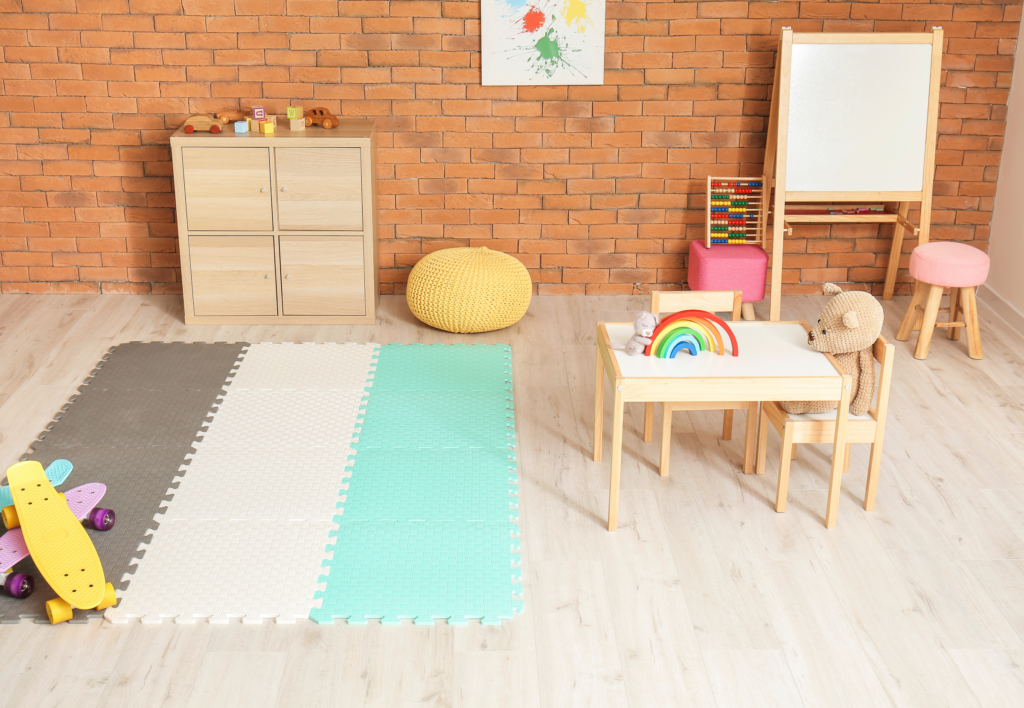
Incorporate Multi-Functional Furniture
In a shared playroom, space is at a premium. Multi-functional furniture can maximize play area while providing storage and other uses.
Why This Idea Works
Multi-functional furniture is a space-saving wonder. It can transform with your needs throughout the day, from storage to play surface, and even to a quiet spot for reading or homework. This adaptability makes it perfect for a dynamic environment like a shared playroom.
Fun Ideas
- Storage Ottomans: These can be used for seating during playtime and tuck away toys when not in use.
- Fold-Down Desks: Attach a fold-down desk to the wall for arts and crafts, which can be stowed away to free up floor space.
- Loft Beds: If the playroom also serves as a bedroom, loft beds with play areas or desks underneath are perfect for saving space.
Quick/Practical Tips
- Look for furniture with rounded corners and soft edges for safety.
- Choose pieces that are low to the ground to be easily accessible for younger children.
- Opt for neutral-colored furniture that can grow with your children and their changing tastes.
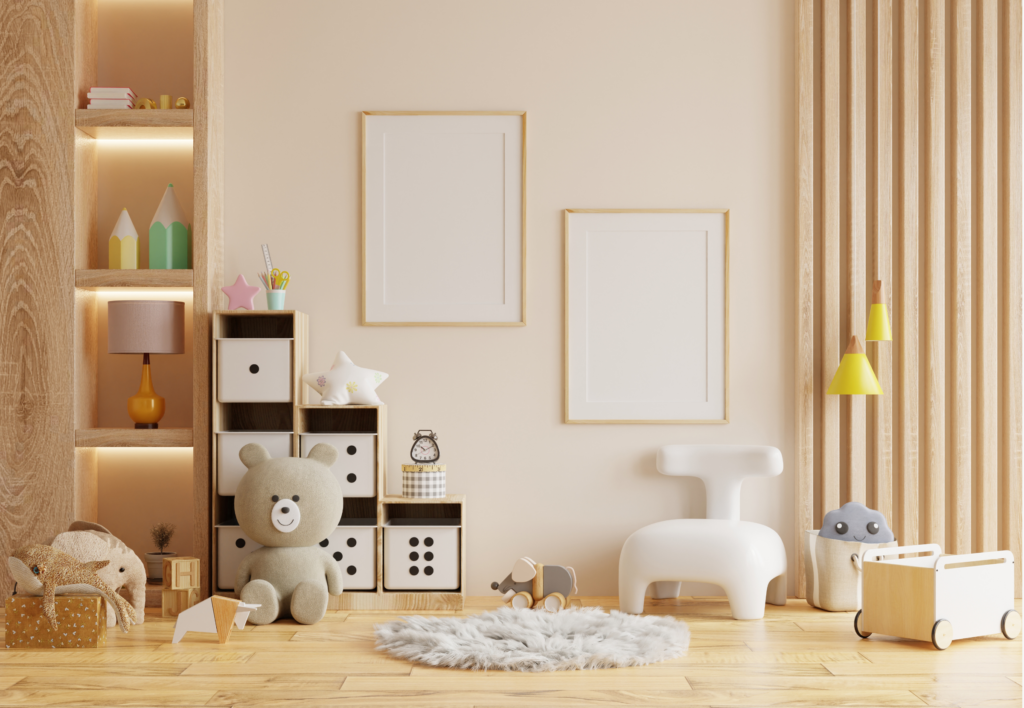
Use Bright and Inviting Color Schemes
Color has a profound impact on mood and creativity, making it a crucial element in any playroom. A bright and inviting color scheme can stimulate the senses and inspire imagination in children of all ages.
Why This Idea Works
Bright colors are naturally appealing to children and can make a playroom feel like a vibrant, energetic place where ideas come to life. Using different colors can also help define the various zones of the playroom without putting up physical barriers that could hinder sibling interaction.
Fun Ideas
- Color Zones: Assign a different color to each area of the room to subtly signal the change in activity zones.
- Accent Walls: Paint one wall with a bold, cheerful color or use fun wallpaper to create a focal point in the room.
- Colorful Accessories: Bright rugs, cushions, and artwork can add splashes of color without overwhelming the space.
Quick/Practical Tips
- Use washable paint for easy cleanup of inevitable scuffs and marks.
- Incorporate a mix of warm and cool colors to balance the energy in the room.
- If you’re hesitant about too much color, start with a neutral base and add colorful accents that can be changed over time.
Build Interactive Walls with Chalkboard or Whiteboard Paint
Transforming a section of your playroom wall into an interactive canvas can provide endless entertainment and a platform for siblings to collaborate creatively.
Why This Idea Works
Chalkboard and whiteboard walls give children the freedom to draw and write at a large scale, which is not only fun but also beneficial for their motor skills development. These walls also offer a reusable space for siblings to play together, whether they’re doodling, practicing spelling, or playing a giant game of tic-tac-toe.
Fun Ideas
- Chalkboard Gallery: Create a chalkboard wall where kids can display their latest and greatest artwork.
- Whiteboard Word Games: Use the whiteboard for educational fun like word games and math challenges.
- Magnetic Paint: Underneath the chalkboard or whiteboard paint, use magnetic paint so the wall can also hold up magnetic letters and numbers.
Quick/Practical Tips
- Frame the painted area with wood trim to define the space and keep chalk dust or marker residue contained.
- Keep a supply of chalk or markers in a nearby basket or shelf that’s easily reachable for kids.
- Regularly clean the wall to keep the space looking fresh and inviting for new creations.

Create Themed Playroom Ideas
A themed playroom can be a magical world for siblings to explore together, sparking imaginative play and shared adventures.
Why This Idea Works
Themes can transport children to another place or time, whether it’s a castle for budding knights and princesses or a space station for young astronauts. A themed environment encourages role-playing, which is a fantastic way for siblings to engage with each other and develop social skills.
Fun Ideas
- Jungle Safari: Decorate with plush animals, a tent, and greenery to simulate a jungle environment.
- Space Odyssey: Use glow-in-the-dark stars and planets, a toy rocket, and metallic surfaces for an out-of-this-world experience.
- Pirate Ship Adventure: A wooden ship structure, treasure chest toy box, and ocean map can create a swashbuckling setting.
Quick/Practical Tips
- Choose a theme that is broad enough for both siblings to find something they love about it.
- Use removable wall decals for an easy and non-permanent way to enhance the theme.
- Incorporate educational elements related to the theme, such as books or puzzles, to blend learning with play.
Flexible Seating Options
A variety of seating choices not only accommodates different activities and preferences but also helps in creating a dynamic and versatile play environment.
Why This Idea Works
Flexible seating allows children to choose where and how they want to engage in an activity, promoting autonomy and comfort. It encourages movement and gives siblings the chance to find their own favorite spot or to gather together for shared play.
Fun Ideas
- Bean Bags: Perfect for lounging, reading, or playing video games, bean bags are a hit with kids and can be easily moved around.
- Floor Cushions: Large cushions can provide a soft area for siblings to sit together for storytime or play board games.
- Small Chairs and Tables: Child-sized chairs and tables are ideal for arts and crafts, homework, or tea parties.
Quick/Practical Tips
- Choose durable and washable materials that can withstand spills and stains.
- Opt for lightweight options that children can move independently, fostering a sense of ownership and responsibility for their space.
- Ensure there is enough seating for each sibling and a friend to prevent conflicts.
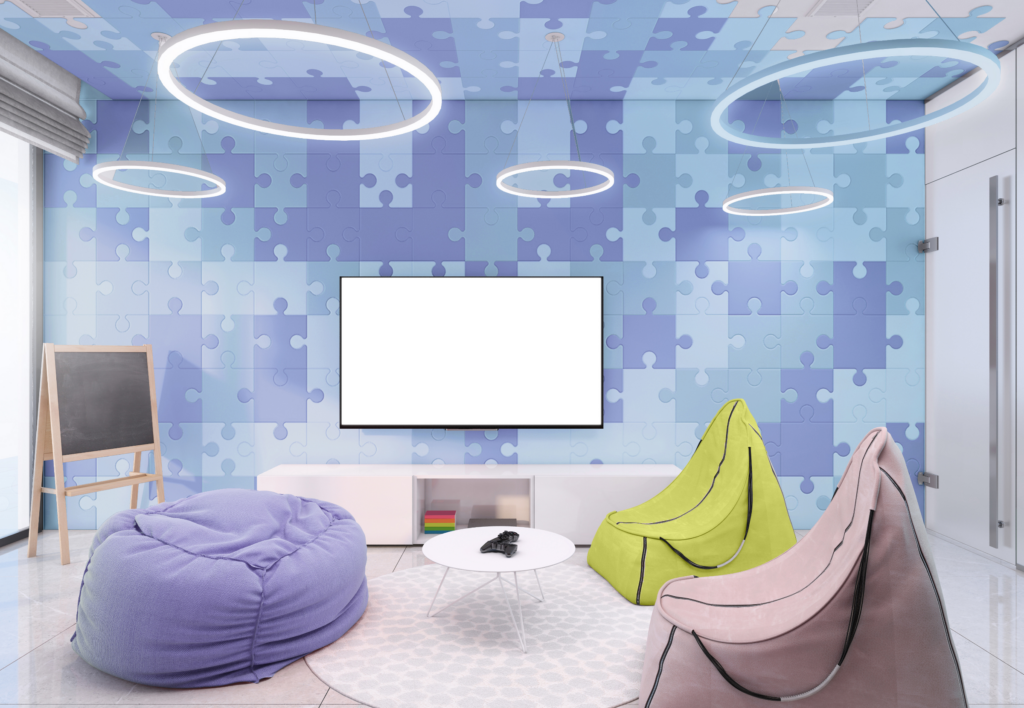
Toy Rotation Strategy
A toy rotation strategy keeps the playroom fresh and engaging without overwhelming it with clutter. This approach also makes playtime more focused and enjoyable.
Why This Idea Works
Children can become overstimulated and bored when faced with too many choices. Rotating toys ensures that they remain interested in their playthings, and it also gives siblings the chance to rediscover old favorites together, sharing memories and experiences.
Fun Ideas
- Themed Bins: Store toys in labeled bins with themes like “Construction,” “Pretend Play,” or “Puzzles” and rotate them weekly or monthly.
- Toy Library: Create a system where siblings can “check out” a toy for a certain period, fostering a sense of respect for shared items.
- Seasonal Swap: Rotate toys based on the season, bringing out water toys in the summer or indoor active games during the winter.
Quick/Practical Tips
- Involve your children in the rotation process to teach them about organizing and decision-making.
- Keep rotated toys out of sight to maintain the novelty when they are reintroduced.
- Be mindful of each child’s current interests to ensure that the toys being rotated in are age-appropriate and engaging for both siblings.
Creative Storage Solutions
Good storage is essential in a shared playroom to keep the space organized and to make cleanup easier for both kids and parents.
Why This Idea Works
Creative storage solutions can make the most of your space and encourage children to take part in tidying up. When everything has a place, siblings are more likely to care for their shared environment and find what they need when they want to play.
Fun Ideas
- Clear Bins: Use clear bins for easy visibility and labeling, so toys can be quickly found and put away.
- Wall Shelves: Install shelves for books, games, and display-worthy toys to keep the floor space clear for play.
- Under-Bed Storage: If the playroom doubles as a bedroom, utilize under-bed storage for toys that are not in daily use.
Quick/Practical Tips
- Implement a “one in, one out” rule when new toys come into the playroom to manage clutter.
- Use pictures on bins for younger children who can’t read yet, so they know where to put things.
- Make sure storage is accessible to children without the need for adult assistance to promote independence.

Dedicated Art and Craft Station
Encouraging creativity is a cornerstone of play, and a dedicated art and craft station can be the perfect outlet for siblings to express themselves and collaborate on projects.
Why This Idea Works
An art station provides a structured area where children can engage in creative activities without worrying about making a mess elsewhere. It’s a space where siblings can bond over shared creations or work on individual projects side by side.
Fun Ideas
- Supply Carousel: A rotating supply holder allows easy access to crayons, markers, scissors, and glue while keeping the tabletop clear.
- Display Area: Incorporate a corkboard or magnetic board for displaying artwork, which can boost confidence and encourage more artistic endeavors.
- Recycling Bin: Keep a bin for recyclable materials that can be used for art projects, teaching resourcefulness and environmental awareness.
Quick/Practical Tips
- Use washable materials wherever possible to make cleanup easier.
- Stock the station with a variety of materials to cater to different ages and interests.
- Keep safety in mind by choosing age-appropriate tools and supervising younger children.
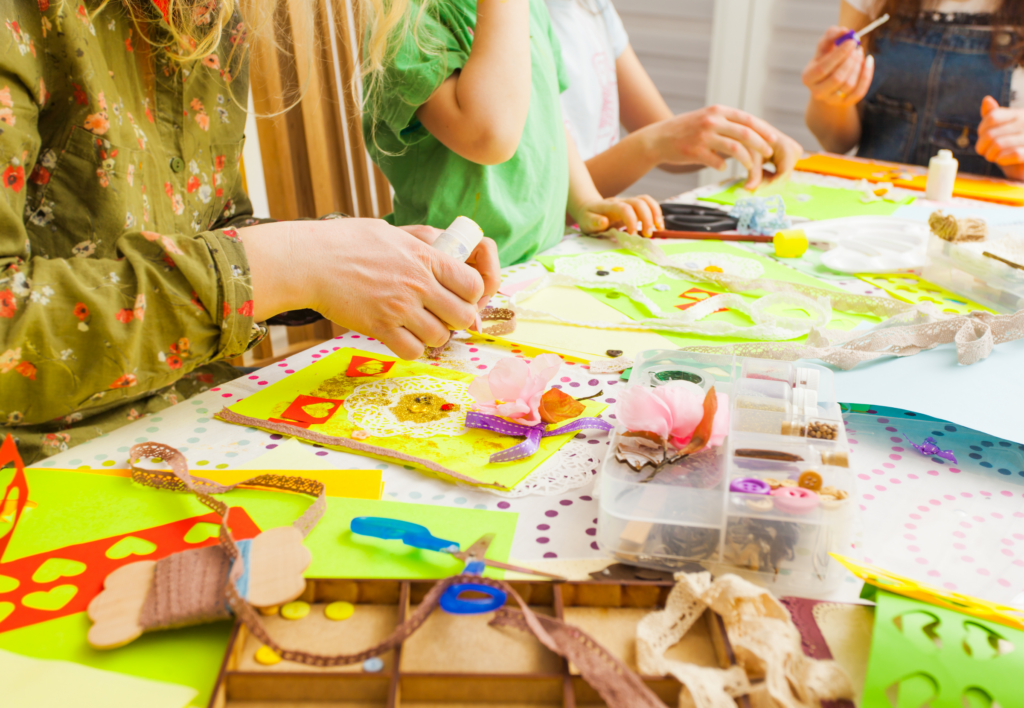
Reading Nook for Quiet Time
A reading nook is a cozy corner where siblings can enjoy quiet time, whether they’re reading together or independently.
Why This Idea Works
Reading is a fundamental skill, and a comfortable, inviting reading nook can help foster a lifelong love of books. It’s also a place where siblings can share stories or read aloud to each other, strengthening their bond and literacy skills.
Fun Ideas
- Canopy or Tent: Create a magical atmosphere with a fabric canopy or a play tent that can be a castle, spaceship, or secret hideaway.
- Bookshelf: A front-facing bookshelf makes it easy for kids to choose their next read and keeps books organized.
- Soft Lighting: Add soft, warm lighting, such as string lights or a reading lamp, to make the space inviting and perfect for reading.
Quick/Practical Tips
- Include a variety of books to cater to different reading levels and interests.
- Make the nook comfortable with pillows, bean bags, and blankets.
- Position the reading nook away from louder play areas to maintain a peaceful environment.
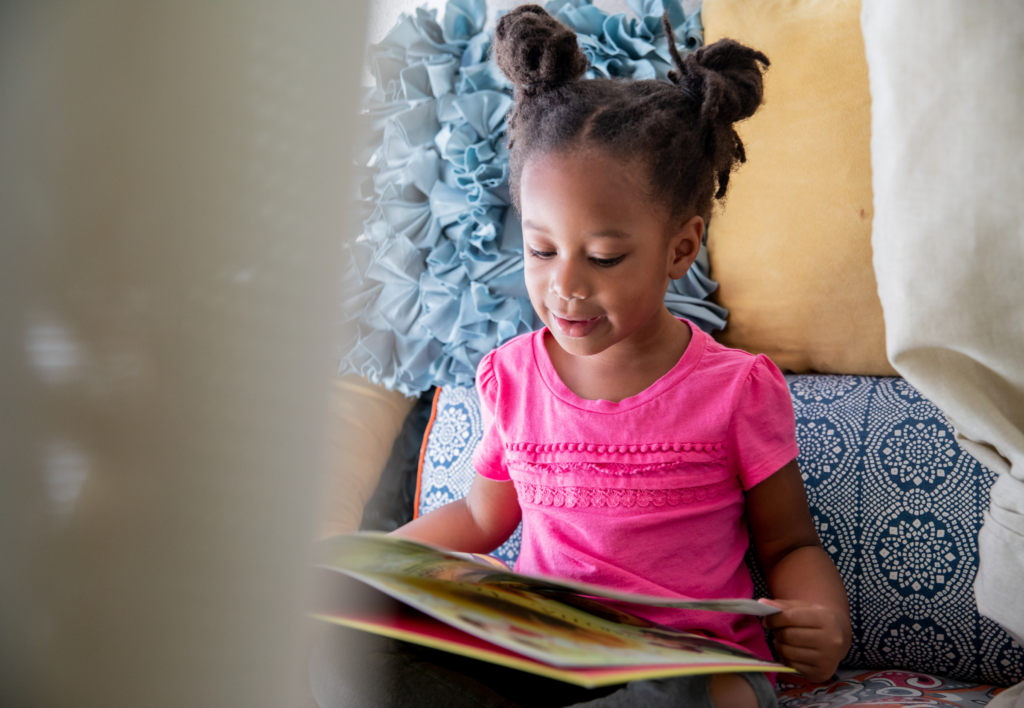
Indoor Activity Area
An indoor activity area can provide a safe space for physical play, which is especially valuable during inclement weather or when outdoor access is limited.
Why This Idea Works
Physical play is crucial for children’s development, and an indoor activity area ensures they can stay active all year round. It’s also a space where siblings can engage in cooperative or competitive play in a controlled environment.
Fun Ideas
- Mini Rock Climbing Wall: A small, safely installed rock climbing wall can challenge children and help develop strength and coordination.
- Slide or Ball Pit: A slide leading into a ball pit provides fun and excitement while also being a great way for kids to expend energy.
- Balance Beams: Low beams can help children develop balance and can be used for imaginative play as pirate planks or tightropes.
Quick/Practical Tips
- Ensure that the play area is padded with mats or soft tiles to prevent injuries.
- Keep the area clear of sharp edges or hard surfaces.
- Regularly check the equipment for safety, and supervise play to ensure it’s being used appropriately.
Technology Corner
In the digital age, a technology corner can be a valuable addition to a playroom, giving siblings a chance to engage with educational software and interactive games.
Why This Idea Works
A dedicated tech space allows for controlled and constructive screen time. It can be an area where siblings learn to cooperate on tech-based projects or games, teaching them digital skills and how to navigate technology together.
Fun Ideas
- Learning Tablets: Stock the tech corner with learning tablets pre-loaded with educational apps and games suitable for various ages.
- Interactive Console: A gaming console with educational and active games can encourage siblings to play and learn together.
- Computer Station: A child-friendly computer can be used for homework, research, and educational activities.
Quick/Practical Tips
- Set clear rules and time limits for technology use to encourage balanced play.
- Use parental controls to ensure children have access to appropriate content.
- Place the technology corner in a location where screen time can be easily supervised.
Outdoor Connection
Even though the playroom is indoors, it’s important to have elements that connect children to the outdoors and nature.
Why This Idea Works
Incorporating nature into play can have calming effects on children and teaches them the importance of the environment. An outdoor connection can also inspire imaginative play that mimics outdoor adventures.
Fun Ideas
- Nature Table: Create a space where kids can display natural finds from the yard or park, such as rocks, leaves, and shells.
- Gardening Corner: Small indoor planters or a hydroponic garden can allow siblings to grow and take care of plants together.
- Seasonal Decor: Decorate the playroom with elements that reflect the current season, bringing a bit of the outside world in.
Quick/Practical Tips
- Choose plants that are non-toxic and easy to care for.
- Use durable containers for the nature table to avoid messes.
- Rotate the seasonal decor to keep the playroom feeling fresh and to teach children about the changing seasons.
Conclusion
Designing a playroom for siblings to share is an exciting project that can result in a space full of laughter, learning, and togetherness. By incorporating designated zones, multi-functional furniture, and a variety of engaging and educational stations, you can create an environment that caters to each child’s needs while also promoting shared experiences. Remember to involve your children in the design process—they’ll be the ones enjoying the space, after all, and their input can be invaluable.
Whether it’s through art, reading, or active play, the ideas we’ve explored can help you set the stage for a playroom that siblings will cherish for years to come. With a little creativity and planning, you can transform an ordinary room into a hub of creativity, play, and sibling harmony.
Let Us Know How We’re Doing!
Did this expertly prepared resource answer your question?
Do you have another question about home maintenance, home improvement projects, home appliance repair, or something else?
Get more information, send in questions and keep the discussion going by contacting the I’ll Just Fix It Myself company customer service team at at 1-800-928-1490 or Email us at [email protected]
